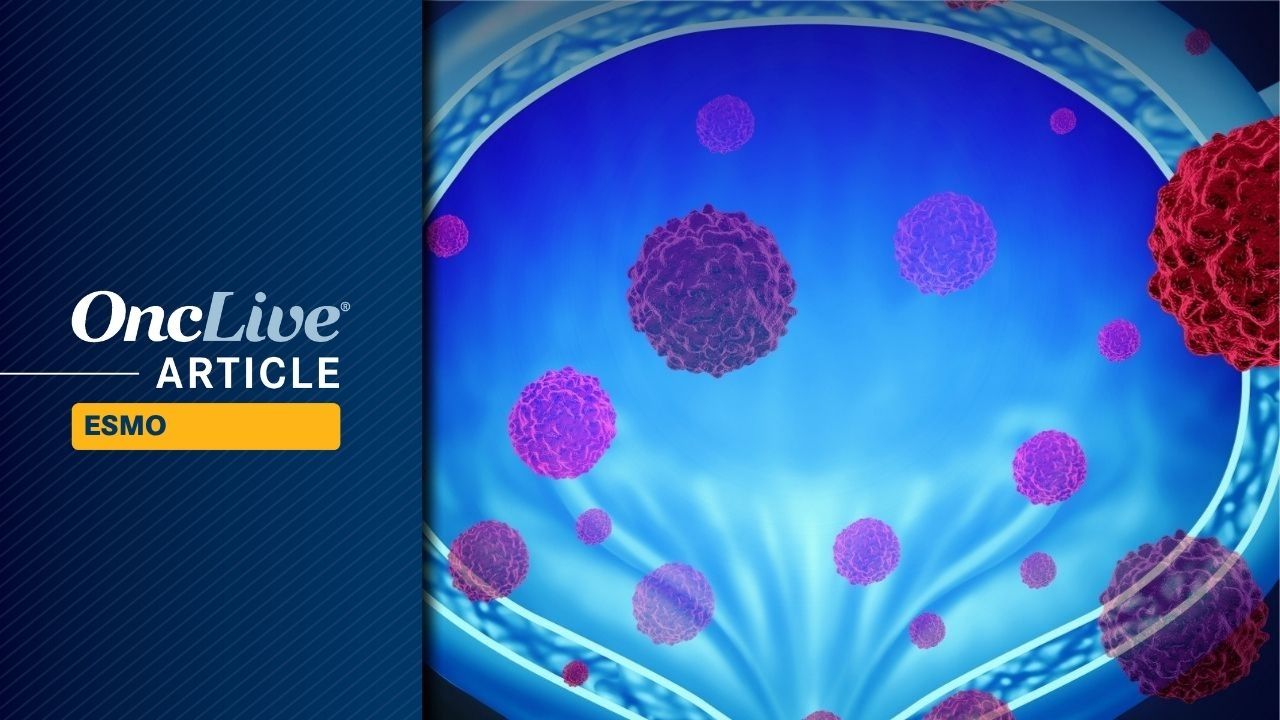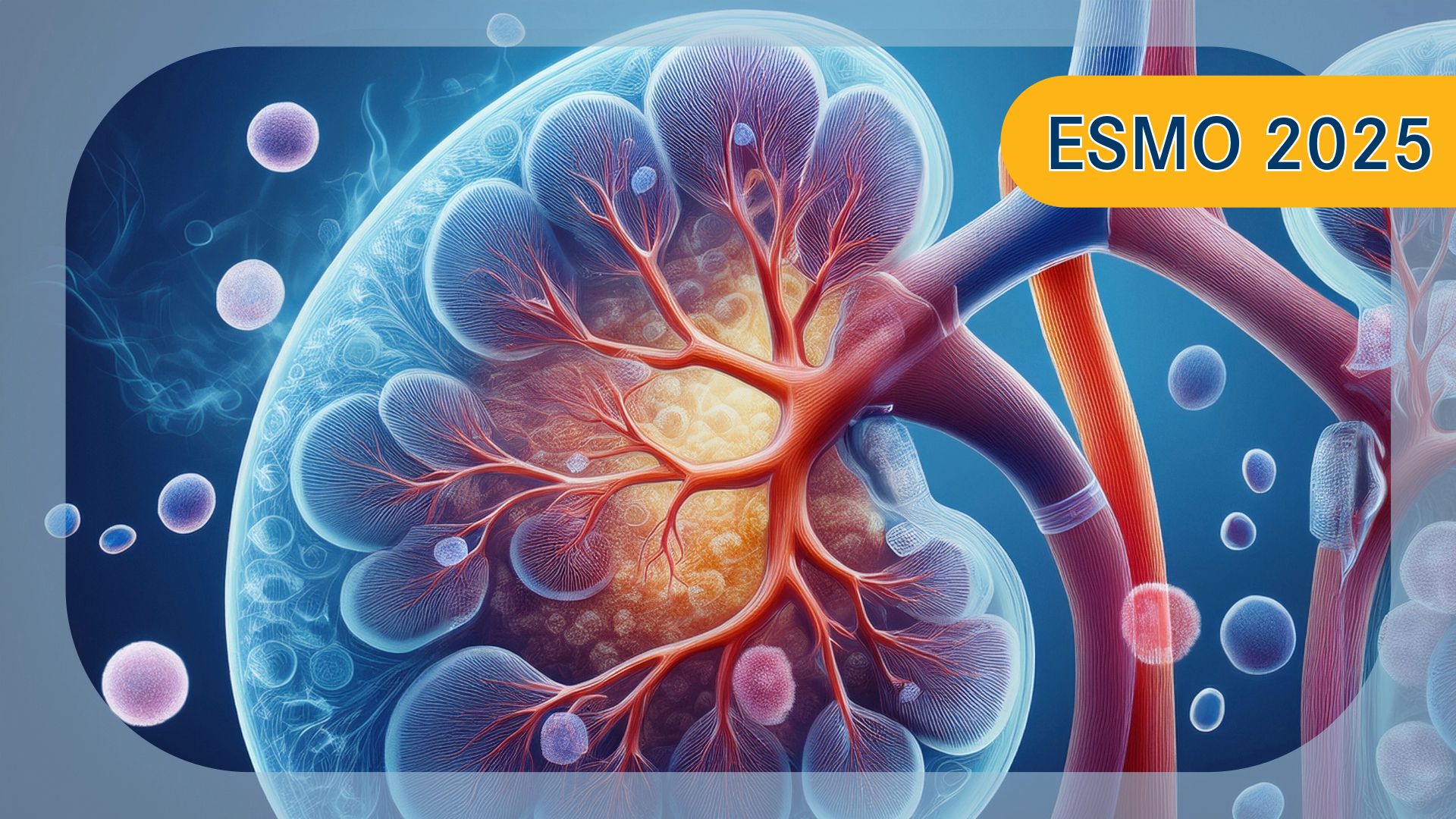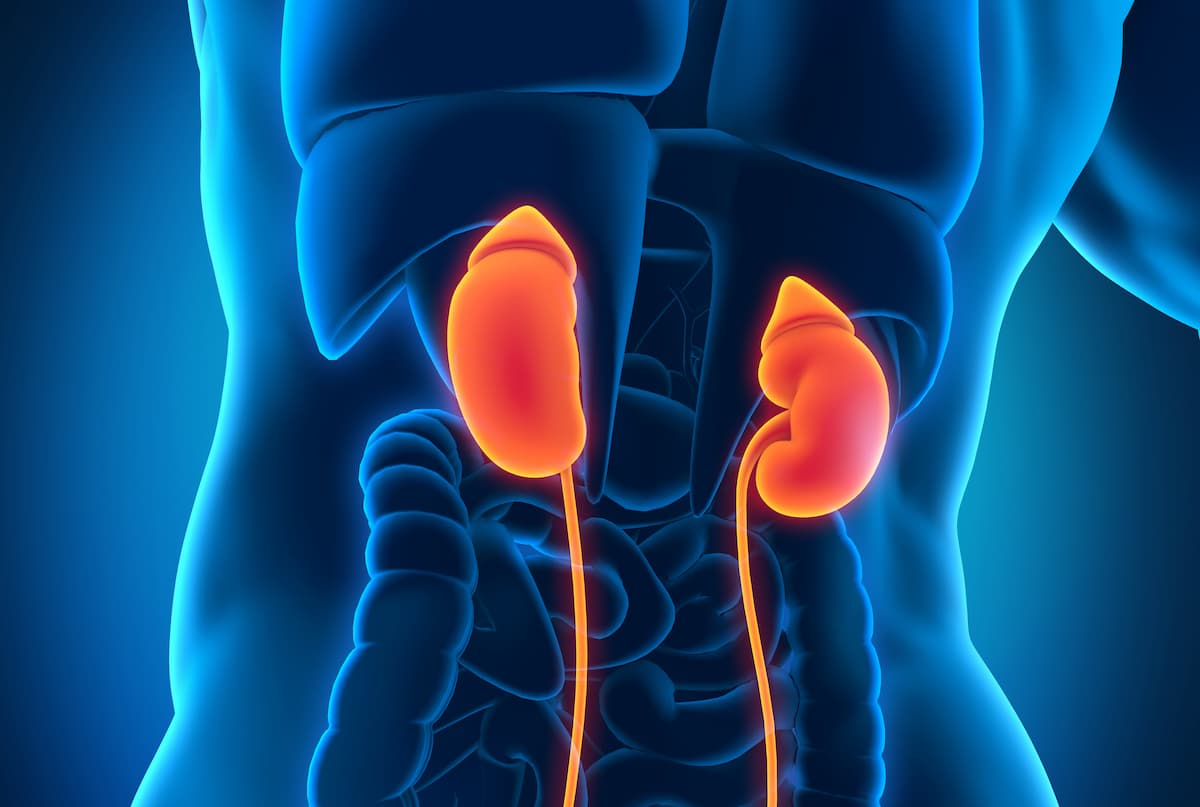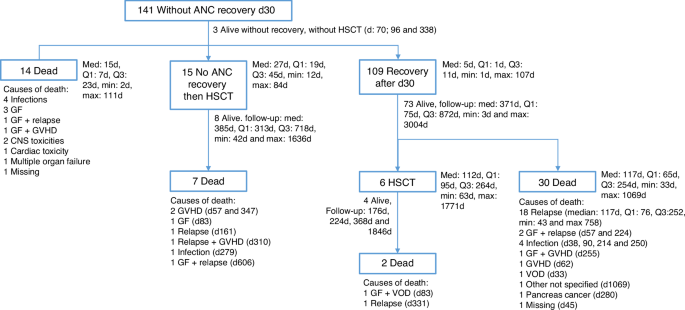The combination of datopotamab deruxtecan-dlnk (Dato-DXd; Datroway) and rilvegostomig demonstrated potent antitumor activity as first-line therapy in cisplatin-ineligible and second-line therapy in platinum-pretreated patients with locally advanced or metastatic urothelial cancer, according to data from cohort 6B of the phase 2 TROPION-PanTumor03 trial (NCT05489211) presented at the
In the first-line cohort (n = 22), the confirmed objective response rate (ORR) was 68.2% (95% CI, 45.1%-86.1%), and the 12-week disease control rate (DCR) was 95.5% (95% CI, 83.4%-99.5%). The median time to response was 1.4 months (range, 1.2-3.9), and the median duration of response (DOR) was not calculable ([NC] 95% CI, 9.4 months to NC). In the second-line cohort (n = 18), the confirmed ORR was 38.9% (95% CI, 17.3%-64.3%), and the 12-week DCR was 83.3% (95% CI, 66.6%-93.7%). The median time to response was 1.3 months (range, 1.2-8.4), and the median DOR was NC (95% CI, 6.9 months to NC).
“The combination of Dato-DXd plus rilvegostomig demonstrated promising efficacy in patients with locally advanced or metastatic urothelial cancer who were cisplatin-ineligible and patients who had progressed on prior platinum-based chemotherapy,” lead study author Sun Young Rha, MD, PhD, professor of medical oncology in the Department of Internal Medicine and the director of Songdang Institute for Cancer Research, Yonsei University College of Medicine, Yonsei University Health System in Seoul, Korea, stated in the presentation.
Main Findings From Cohort 6B of the TROPION-PanTumor03 Trial
- Cisplatin-ineligible patients experienced an ORR of 68.2% and median PFS that was not calculable.
- Platinum-pretreated patients experienced an ORR of 38.9% and median PFS of 12.5 months.
- Adverse effects of special interest for dato-DXd included oral mucositis/stomatitis, ocular surface events, and adjudicated drug-related interstitial lung disease/pneumonitis.
What Was TROPION-PanTumor03 Designed to Answer?
Despite the evolution in first- and second-line treatments for patients with locally advanced or metastatic urothelial cancer, a clinical need remains for effective therapy. Dato-DXd is a TROP2-directed antibody-drug conjugate (ADC) and rilvegostomig is an Fc-reduced, monovalent, bispecific IgG1 antibody directed against PD-1 and TIGIT receptors.
TROPION-PanTumor03 is an open-label trial evaluating dato-DXd as monotherapy or in combination with anticancer agents in patients with advanced or metastatic solid tumors.2
Investigators enrolled patients with histologically confirmed, unresectable, locally advanced or metastatic urothelial cancer who had not received prior PD-(L)1, CTLA-4, or TIGIT inhibitors, enfortumab vedotin-ejfv (Padcev), or TROP2-directed or deruxtecan-based ADCs.1 Patients had to be cisplatin-ineligible in the first-line setting or platinum-treated in the second line. Patients in the former cohort also had to have either an ECOG performance status between 0 and 2, creatinine clearance of at least 30 mL/min but less than 60 mL/min, NCI CTCAE 5.0 grade 2 or greater hearing loss, or NCI CTCAE 5.0 grade 2 or greater peripheral neuropathy. Patients in the latter cohort had to also have an ECOG performance status of 0 or 1.
Forty patients received 6 mg/kg of intravenous dato-DXd every 3 weeks plus 750 mg of rilvegostomig every 3 weeks in the first- and second-line cohorts. In the first-line cohort, the median age was 71 years (range, 53-85). Most patients were male (77.3%), had an ECOG performance status of 0 (77.3%), and had AJCC stage IV disease (86.4%). Most patients were untreated (86.4%), although some had received neo(adjuvant) cisplatin therapy (13.6%). In the second-line cohort, the median age was 66 years (range, 56-78). Most patients were male (83.3%), had an ECOG performance status of 0 (72.2%), and had AJCC stage IV disease (88.9%). Most patients had received 1 prior line of therapy (61.1%), with cisplatin (88.9%) being the most common.
The primary end points were investigator assessed ORR per RECIST 1.1 criteria, safety, and tolerability. Secondary end points were DCR, DOR, and investigator assessed progression-free survival (PFS) per RECIST 1.1 criteria.
How Durable Were the Responses?
In the first-line cohort, the median PFS was NC (95% CI, 10.8 months to NC) at median follow-up of 10.8 months (range, 2.6-19.4); the 6- and 12-month PFS rates were 85.9% (95% CI, 62.4%-95.2%) and 73.5% (95% CI, 46.5%-88.4%), respectively. In the second-line cohort, the median PFS was 12.5 months (95% CI, 4.2-NC) at median follow-up of 9.7 months (range, 8.1-17.8); the 6- and 12-month PFS rates were 72.2% (95% CI, 45.6%-87.4%) and 60.0% (95% CI, 33.7%-78.7%), respectively.
Was the Regimen Well Tolerated?
In the first- and second-line cohorts, respectively, treatment-related adverse effects (TRAEs) led to dose reduction (63.6% vs 22.2%), interruption (45.5% vs 33.3%), and discontinuation (9.1% vs 16.7%).
“The safety profile of Data-DXd plus rilvegostomig was consistent with previous reports of this combination. No new safety signals were identified,” Rha stated.
Adverse effects of special interest (AESIs) for Dato-DXd in the first-line cohort included oral mucositis/stomatitis (any grade, 40.9%; grade ≥3, 0%), ocular surface events (any grade, 18.2%; grade ≥3, 0%), and adjudicated drug-related interstitial lung disease (ILD)/pneumonitis (any grade, 4.5%; grade ≥3, 0%). AESIs for rilvegostomig included hepatic events (any grade, 13.6%; grade ≥3, 0%), diarrhea/colitis (any grade, 4.5%; grade ≥3, 0%), dermatitis/rash (any grade, 50.0%; grade ≥3, 0%), and infusion-related reaction/hypersensitivity reaction (any grade, 9.1%; grade ≥3, 0%).
AESIs for Dato-DXd in the second-line cohort included oral mucositis/stomatitis (any grade, 61.1%; grade ≥3, 5.6%), ocular surface events (any grade, 22.2%; grade ≥3, 0%), and adjudicated drug-related ILD/pneumonitis (any grade, 11.1%; grade ≥3, 0%). AESIs for rilvegostomig included hepatic events (any grade, 5.6%; grade ≥3, 5.6%), diarrhea/colitis (any grade, 5.6%; grade ≥3, 0%), and dermatitis/rash (any grade, 44.4%; grade ≥3, 0%).
The most common TRAEs that occurred in at least 10% of patients in the first- and second-line cohorts, respectively, were stomatitis (40.9% vs 50.0%), nausea (18.2% vs 44.4%), asthenia (40.9% vs 5.6%), fatigue (13.6% vs 33.3%), rash (31.8% vs 0%), amylase increase (22.7% vs 56.7%), decreased appetite (22.7% vs 16.7%), constipation (22.7% vs 11.1%), pruritus (13.6% vs 22.2%), decreased neutrophil count/neutropenia (4.5% vs 22.2%), alopecia (18.2% vs 16.7%), anemia (9.1% vs 16.7%), dry eye (13.6% vs 5.6%), aspartate aminotransferase increase (13.6% vs 0%), and dry mouth (0% vs 11.1%).
“These results warrant further exploration of Dato-DXd plus rilvegostomig in the first-line locally advanced or metastatic setting,” Rha concluded.
Disclosures: Rha reported being a consultant or advisor for Amgen, Arcus Biosciences, Astellas Pharma, AstraZeneca, Eisai, Jazz, Daiichi Sankyo, Gilead, Indivumed, LG Chem, MSD Oncology, Ono Pharmaceutical, and Toray Inc; speaker for Amgen, Arcus Biosciences, Astellas Pharma, AstraZeneca, Bristol-Myers Squibb/Ono, Daiichi Sankyo, Eisai, BeOne, and MSD Oncology; and research funding from Amgen (inst), ASLAN Pharmaceuticals, Astellas Pharma, AstraZeneca, Bayer, BeOne, Bristol-Myers Squibb, Daiichi Sankyo, Eisai, Indivumed, Eli Lilly, Gilead, MSD Oncology, Roche/Genentech, Sillajen, and Jazz.
References
- Young Rha S, Lim SH, Zhou F, et al. Datopotamab deruxtecan (Dato-DXd) + rilvegostomig (rilve) in patients (pts) with locally advanced or metastatic urothelial cancer (a/mUC): results from the phase 2 TROPION-PanTumor03 study. Presented at: 2025 ESMO Congress; October 17-21, 2025; Berlin, Germany. Abstract 3072MO.
- Study of dato-DXd as monotherapy and in combination with anti-cancer agents in patients with advanced solid tumors (TROPION-PanTumor03). ClinicalTrials.gov. Updated July 11, 2025. Accessed October 18, 2025. https://www.clinicaltrials.gov/study/NCT05489211








